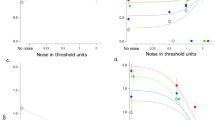Abstract
Purpose
External visual noise plays a major role in real life, for instance, when a driver tries to identify an object through a snow flurry or through a dirty windshield. The goal of the present investigation was to quantify, under such a condition, the advantage of binocular over monocular vision or, rather, the disadvantage of having only one eye.
Methods
Eight observers judged the orientation of a Landolt ring (gap always 10 arcmin), partly obscured by noise particles of different sizes (5, 10 or 20 arcmin). The noise particles were presented at a stereo disparity of 62 arcmin, i.e. beyond Panum’s fusional area. We compared the percentage of correct responses and the reaction time between binocular and monocular vision. Control conditions: (1) binocular vision with noise particles located immediately in front of the Landolt ring (stereo disparity ± 0), and (2) absence of noise particles.
Results
With regard to the percentage of correct responses, an advantage of binocular over monocular observation occurred only when the obscuring particles were presented at the stereo disparity of 62 arcmin. The advantage depended on the size of the noise particles. The factor was 1.24 for particles of 5 arcmin, 1.49 for 10 arcmin and 1.59 for 20 arcmin. With regard to the reaction time, there was no difference between binocular and monocular vision.
Conclusion
Binocular vision provides a considerable advantage over monocular vision when particles partly obstruct the view. This advantage is due to the capability of the visual system to construct a coherent percept of an object of which different parts are imaged in the right and left eye.



Similar content being viewed by others
References
Andersen GJ (1990) Focused attention in three-dimensional space. Percept Psychophys 47:112–120
Arnold DH, Grove PM, Wallis TS (2007) Staying focused: a functional account of perceptual suppression during binocular rivalry. J Vis 7:1–8
Aulhorn E (1967) Die gegenseitige Beeinflussung abbildungsgleicher Netzhautstellen bei normalem und gestörtem Binokularsehen [The reciprocal effect exerted by retinal areas (perceiving) identical images in normal and disturbed binocular vision]. Doc Ophthalmol 23:26–61
Bacon BA, Mamassian P (2002) Amodal completion and the perception of depth without binocular correspondence. Perception 31:1037–1045
Banton T, Levi DM (1991) Binocular summation in vernier acuity. J Opt Soc Am A 8:673–680
Bauer A, Dietz K, Kolling G, Hart W, Schiefer U (2001) The relevance of stereopsis for motorists: a pilot study. Graefes Arch Clin Exp Ophthalmol 239:400–406
Bauer A, Kolling G, Dietz K, Zrenner E, Schiefer U (2000) Are cross-eyed persons worse drivers? The effect of stereoscopic disparity on driving skills. Klin Monbl Augenheilkd 217:183–189
Changizi MA, Shimojo S (2008) "X-ray vision" and the evolution of forward-facing eyes. J Theor Biol 254:756–767
Dengler B, Kommerell G (1993) Stereoscopic cooperation between the fovea of one eye and the periphery of the other eye at large disparities. Implications for anomalous retinal correspondence in strabismus. Graefes Arch Clin Exp Ophthalmol 231:199–206
Fleck R, Kolling GH (1996) Two new stereotests for long distance: examination of stereopsis with regard to the permission of driving. Ger J Ophthalmol 5:53–59
Forte J, Peirce JW, Lennie P (2002) Binocular integration of partially occluded surfaces. Vision Res 42:1225–1235
Hibbard PB, Bradshaw MF, DeBruyn B (1999) Global motion processing is not tuned for binocular disparity. Vision Res 39:961–974
Howard IP (2002) Seeing in Depth—Volume 1 Basic Mechanisms. Porteous, I. University of Toronto Press, Toronto
Jones RK, Lee DN (1981) Why two eyes are better than one: the two views of binocular vision. J Exp Psychol Hum Percept Perform 7:30–40
Levi DM, Harwerth RS, Smith EL (1980) Binocular interactions in normal and anomalous binocular vision. Doc Ophthalmol 49:303–324
McKnight AJ, Shinar D, Hilburn B (1991) The visual and driving performance of monocular and binocular heavy-duty truck drivers. Accid Anal Prev 23:225–237
Meese TS, Hess RF (2005) Interocular suppression is gated by interocular feature matching. Vision Res 45:9–15
Moraglia G, Schneider B (1992) On binocular unmasking of signals in noise: further tests of the summation hypothesis. Vision Res 32:375–385
Nakayama K, Shimojo S, Silverman GH (1989) Stereoscopic depth: its relation to image segmentation, grouping, and the recognition of occluded objects. Perception 18:55–68
Reiner J (1989) Irritation des binokularen Sehens durch Wischerspuren an Windschutzscheiben. Klin Monatsbl Augenheilkd 194:62–64
Shimojo S, Nakayama K (1990) Real world occlusion constraints and binocular rivalry. Vision Res 30:69–80
van den Berg AV, Brenner E (1994) Why two eyes are better than one for judgements of heading. Nature 371:700–702
Wakayama A, Matsumoto C, Shimomura Y (2005) Binocular summation of detection and resolution thresholds in the central visual field using parallel-line targets. Invest Ophthalmol Vis Sci 46:2810–2815
Wood JM, Collins MJ, Carkeet A (1992) Regional variations in binocular summation across the visual field. Ophthalmic Physiol Opt 12:46–51
Zohary E, Shadlen MN, Newsome WT (1994) Correlated neuronal discharge rate and its implications for psychophysical performance. Nature 370:140–143
Acknowledgement
The Deutsche Forschungsgemeinschaft (KO 761/2-1) supported this research.
Author information
Authors and Affiliations
Corresponding author
Rights and permissions
About this article
Cite this article
Otto, J.M., Bach, M. & Kommerell, G. Advantage of binocularity in the presence of external visual noise. Graefes Arch Clin Exp Ophthalmol 248, 535–541 (2010). https://doi.org/10.1007/s00417-010-1304-2
Received:
Revised:
Accepted:
Published:
Issue Date:
DOI: https://doi.org/10.1007/s00417-010-1304-2




